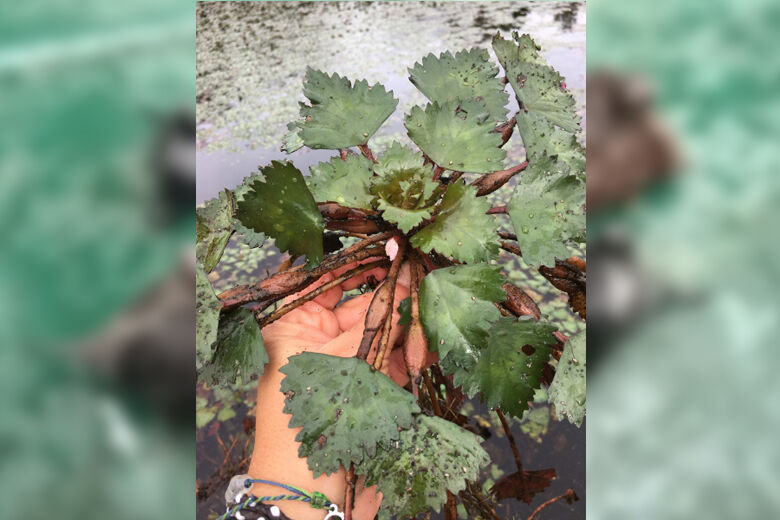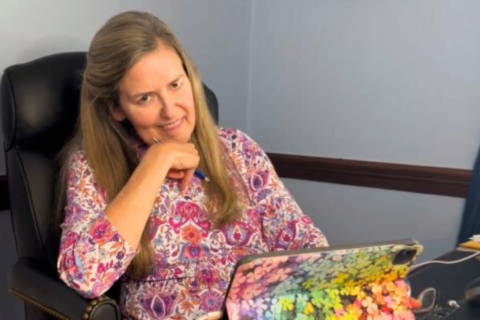
Efforts are ramping up to root out an invasive plant that biologists say is a very bad actor — a type of water chestnut that’s been found in Northern Virginia in recent years.
A biologist and concerned citizens are among those working to get rid of it.
“This plant has the potential to be ‘the bad and the ugly,’ which, combined, is evil. I just made that up, but it’s true,” said John Odenkirk with the Virginia Department of Wildlife Resources.
“The reason I called it the evil weed, maybe, was to try to bring a little bit more focus and attention to the fact that this really could be very problematic as an invasive organism, (an) invasive aquatic plant,” he said.
Odenkirk is speaking of a type of water chestnut called trapa bispinosa that’s been a growing nuisance lately.
“This is not the water chestnuts that people eat in Chinese restaurants,” Odenkirk said.
“So this plant, more than any other plant I’ve ever seen, forms extraordinarily dense colonies, effectively a monoculture where it’s the only plant species within that area, and it grows so closely and clustered so tightly together,” Odenkirk told WTOP.
“Think of it as an umbrella, and it’s completely adjoining, and so, therefore, shutting off all sunlight transmission,” he said.
The effect of that thick blanket of roots, stems and leaves in these colony formations means most sunlight doesn’t penetrate the water — which prevents photosynthesis which is “one of the main ways you get oxygen in the water,” Odenkirk said.
Because of that, “your oxygen content [in the water] is going to go down, potentially to lethal levels for many species of fish,” Odenkirk said.
Fighting the invasion
Biologists and volunteers are working to keep the trapa bispinosa from spreading to creeks and rivers, where it could potentially affect “fish that we might like to eat like striped bass, blue crabs, organisms that need oxygen and need habitat and space that we might like to eat,” Odenkirk said.
He said colonies have exploded in the past couple of years and have been found at more than 80 sites.
Meanwhile, the Bay Journal reports discoveries in a Virginia county — 200 miles south of the D.C. area, as well as sightings of trapa bispinosa in Prince George’s County, Maryland.
Odenkirk, who also keeps track of the invasive snakehead fish species in Virginia, said there’s an avian suspect that is thought to be spreading these water chestnut seeds from pond to pond, as it goes about its daily business.
“I think Canada geese are our biggest culprit,” he said, noting that there isn’t any scientific evidence so far, but among the sites where this plant has exploded, “all these sites are heavily visited by Canada geese. So we’re pretty sure that’s the primary mechanism of dispersal.”
Odenkirk said there is not much they can do about the geese, but people are banding together, including groups of volunteers who go out and pull up these water chestnuts by hand.
Odenkirk said funding is still a need. He credits retired U.S. Geological Survey botanist Nancy Rybicki, working pro bono, with keeping track of current sites where the plant is located, helping to coordinate response and providing technical assistance to private pond owners who find these plants in their waters but don’t know what to do about them.
“We just need the money to have a dedicated person or two, to coordinate and bring everyone together, and court and recruit the legions of volunteers because most of this is going to be hand harvesting,” he said, adding that funding avenues are opening up to help with eradication efforts — which is also reported by Bay Journal.
He has good things to say about pulling up these plants by hand.
“Hand harvesting is very effective. It’s cheap because chemicals are the other major alternative. And the chemicals are very expensive, and they can be safe if applied properly … Typically, what we’ll do is we’ll get a cadre of volunteers. And there’s more people than you might expect that are willing to get wet and muddy on a hot day, pulling plants out,” Odenkirk said.






